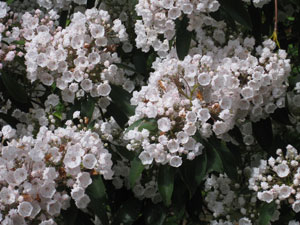Resource Library
Plant of the Week: Mountain Laurel
The University of Arkansas System Division of Agriculture does not promote, support or recommend plants featured in "Plant of the Week." Please consult your local Extension office for plants suitable for your region.
Plant of the Week
Mountain Laurel
Latin: Kalmia latifolia

I fancy myself an enthusiast for all things ericaceous – that is members of the azalea family. While mostly I grow azaleas and rhododendrons in my garden, I lust after other members of the tribe but find them difficult to establish and grow long term in the garden. One of the plants I would like to grow, but so far it has failed me, is Mountain Laurel (Kalmia latifolia) of our eastern states.
Mountain laurel is a mounded evergreen shrub usually seen growing 7 to 10 feet tall and wide but, in the southern Appalachians it can take on tree like stature and reach 25 feet in height where it forms tangled, impenetrable thickets. It is the most widely distributed of the eight species of Kalmia – all native to North America and Cuba – with a range from Canada to northern Florida to Louisiana. While typically found in the Appalachians it does grow in warmer climes along the upper banks of rivers in the Gulf Coastal region.
The evergreen leaves are 2 to 4 inches long, elliptical in outline and bright green though often marked in the wild with the circular red dots of an endemic leafspot disease. Flowers are produced in terminal trusses of 50 to 150 blooms in shades of white, pink or deep rose, often marked at the periphery with purple blotches or lines. Individual flowers are cup-shaped when fully opened and just less than an inch across. The flower buds, as they make their way to flower, are as beautiful and intriguing as the open flowers. Flowering is typically during late spring coming in sequence after the rhododendrons have finished blooming.
This plant is quite showy when in bloom and caught the attention of early naturalists as they traveled in the eastern states. Mark Catesby (1683 – 1749), an English naturalist who published the first lavishly illustrated account of the plants and animals of the New World between 1729 and 1747, was enraptured by the plant and introduced it to England in 1734. Catesby called the plant Chamaedaphne foliis tini but in 1753 Linnaeus officially named it after his friend and fellow botanist Peter Kalm from Finland who had traveled in the northeastern parts of North America where he collected specimens of the plant.
Kalmia has a strong following in the eastern states where several hundred cultivars have been selected. Most of the breeding work on the group has been done in New England as chronicled by Dr. Richard Jaynes in his book on the subject. Unfortunately, these northern-bred plants are not so well suited for the gardens of Arkansas where they often struggle and ultimately die. Like so many other kinds of garden plants, one can only imagine what kind of outcome would have been achieved if the breeding program had been done in Atlanta or some other southern city using breeding stock adapted to the heat and humidity of the South.
Mountain laurel is considered a tricky plant for nurserymen to produce so it is not surprising that it is difficult for gardeners out of the range where it occurs naturally to grow it successfully. If you try it choose a north facing slope or the east side of your house. Don’t plant it in the ground but instead, plant it on top of the ground and add a bed of composted pine bark around the roots. It must have acidic soils and excellent drainage if it is expected to survive. Keep it watered during dry spells and make sure it is mulched anew each season. Bright but indirect light is probably the best exposure for the plant giving it enough light for good bloom set but not so much as to over stress the plant during our hot summers.
By: Gerald Klingaman, retired
Retired Extension Horticulturist - Ornamentals
Extension News - June 15, 2012
The University of Arkansas System Division of Agriculture does not maintain lists of retail outlets where these plants can be purchased. Please check your local nursery or other retail outlets to ask about the availability of these plants for your growing area.